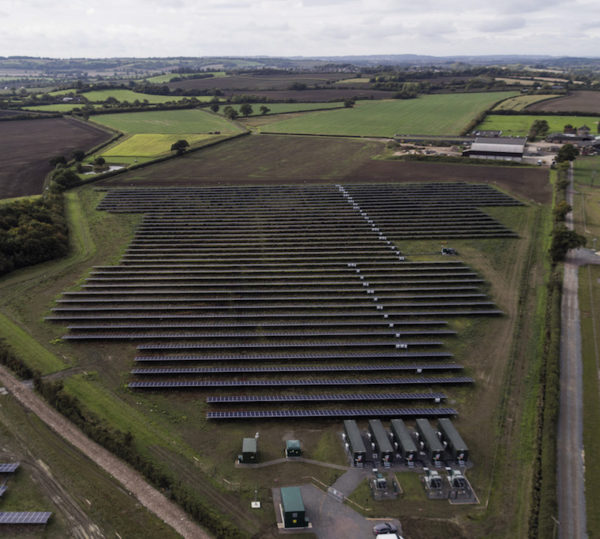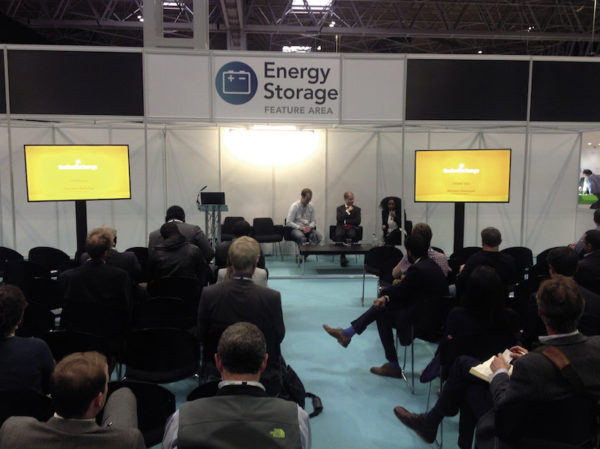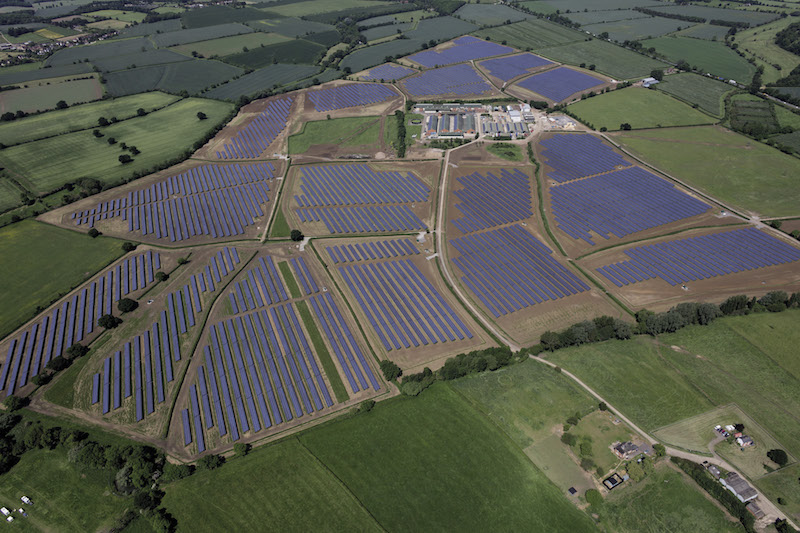U.K. solar, the surprise PV market of the past few years, is set to face a difficult immediate future, due to changes in the policy schemes that supported its initial growth. Specifically, the British Government scrapped the Renewables Obligation Certificate (ROC) scheme in 2015, however a large number of projects were grandfathered, meaning a portfolio of new large-scale projects continued to be built in the country until the end of this year’s first quarter. The grandfathering time window has now closed, and the only public subsidy support still in place is a significantly lowered feed-in tariff (FIT) for small-scale projects, whose cumulative capacity is furthermore capped.
Meanwhile, the sector has received a few well needed doses of optimism in recent months, linked to the inauguration of the U.K.’s first subsidy-free PV plant in September, the government’s decision in July to ban the sale of new petrol and diesel cars from 2040 (thus boosting the EVs trend), and a handful of community energy project deals. The common denominator to all three of these categories though, is energy storage and smart technologies.
Subsidy-free solar
British renewable energy developer Anesco unveiled in September the 10 MW Clayhill solar farm in Bedfordshire, co-located with a 6 MW battery storage facility. The Clayhill solar farm will not receive any form of public subsidy, however it is built near another PV farm that is a recipient of ROCs. This means that a lot of infrastructure needed to build the Clayhill farm was already in place. More importantly, by adding the storage facility to the complex, Anesco will be able to sell ancillary services to the National Grid, the U.K.’s owner and operator of the transmission system, which relies on such services to maintain the stability of the electricity system.
Another piece of news that turned heads both in the U.K. and abroad was the British regulator Ofgem’s decision in September to allow Anesco to retain its ROC certificates for the electricity generated via three solar farms – each 5 MW in size and supported by a 1.1 MWh battery – regardless of whether the generated electricity is exported to the grid or stored in the batteries. That was a landmark decision that has the potential to alter the U.K.’s solar landscape. The downside to this development is that the number of existing solar projects where it is possible to retrofit energy storage facilities is naturally limited (the solar projects should be in an area that needs grid support for example).
For this reason, Anesco’s subsidy-free 10 MW Clayhill PV farm co-located with a subsidy-free battery is even more important. To this end though, the U.K.’s Solar Trade Association (STA) appears less optimistic, in the immediate term at least. An STA spokesperson told the Financial Times that the association absolutely applauds Anesco, “but government shouldn’t then assume the industry is away – it isn’t … It is only going to be exceptional projects that are built subsidy-free. What we are asking for is a level playing field for solar power.” STA’s level playing field comment refers to the British Government excluding large solar PV plants from the new Contracts-for-Difference (CfDs) auctions, which is the U.K.’s new scheme for the support of renewable energy.
The great EV hope
The U.K. Government’s decision to ban the sale of new petrol and diesel cars from 2040, alongside a plethora of grants to local governments to develop infrastructure that facilitates the adoption of EVs, is also being widely discussed across the solar PV sector.

Image: Anesco
Mike O’Hare, Senior Development Manager at National Grid Ventures, which focuses on the energy systems of tomorrow while also continuing to support National Grid’s regulated core business, told the U.K. Solar and Storage show in Birmingham in October that the roll-out of EVs will increase the country’s electricity demand, but smart charging (referring to both the time and location of charging) will be key if EVs are to be efficiently integrated into the electricity system.
O’Hare also said that the plug-in of EV batteries to the electricity grid will be necessary to manage peak demands, and that providing vehicle to grid services could be promoted by providing incentives. Such an example, O’Hare added, is the recent announcement by OVO Energy, a power supplier based in Bristol, which starting from next year will offer free electric charging to Nissan Leaf car owners who provide vehicle to grid services.
Energy community projects
Speaking at the Solar and Storage Live show in Birmingham was Emma Bridge, Chief Executive of Community Energy England, a membership body that supports organizations that want to see the community sector grow. Bridge said that the U.K. has installed 188 MW of community renewable energy projects and referred to a few impressive community projects, such as a 14.7 MW solar PV farm near Stratford-upon-Avon in Warwickshire, a 636 kW rooftop PV array on the roof of a tyre factory in Milton Keynes, and a project of 321 council-owned homes with PV and battery assets.
With regards to the 14.7 MW PV farm, British community energy developer Mongoose Energy, will buy it from Anesco and it will be the largest U.K. community project. The farm comprises three PV arrays that receive ROCs and “will feature co-located batteries that are accredited for subsidy-backed revenue streams including FITs and ROCs,” said Mongoose Energy. Furthermore, Mongoose Energy secured funding with bridge financing provided by Social and Sustainable Capital (SASC) and senior debt provided by Close Brothers. “Mongoose Energy will start to repay the bridge finance from SASC via a series of community share and bond offers in the Autumn, to be hosted on Mongoose’s proprietary crowd funding platform.”

What happens though with projects that do not have access to subsidies? Matthew Clayton, Managing Director of Thrive Renewables, a British renewable energy investment company, told the Solar and Storage show that subsidy-free community energy projects in the U.K., up to 5 MW each, are between 18 and 24 months away from being able to access funding. An exception to this is when the project does not sell the generated power to the grid, but instead relies on a direct power purchase agreement (PPA) contract. In this case, explained Clayton, the project can be viable already with the current technology, project development, and financing costs. In other words, innovative financing and business models are key to developing new community energy projects. Business models though depend on the revenue streams, and therefore it becomes clear once again that smart technologies will be crucial in the post-subsidy era.
Smart systems and flexibility plan
One strength of smart technologies and energy storage specifically is that the U.K. government has at last showed signals that it grasps the issue correctly, and is in the process of making new policies that could boost the smart energy sector. This discussion leads inevitably to the ‘Smart Systems and Flexibility Plan,’ published jointly by the U.K. Government and Ofgem in July. According to this plan, the government sets actions it needs to take in three broad areas: removing regulatory barriers to smart technologies; enabling EVs, smart homes, and businesses; and promoting markets which work for flexibility.
Regarding the regulatory barriers, it is very useful that the government has decided to amend the Electricity Act 1989 and define storage explicitly as a distinct subset of generation. Consequently, a new, modified license for storage will be introduced by summer 2018, while “the license changes will be designed to enable storage facilities to identify themselves as exempt from so-called final consumption levies, as storage facilities are not end consumers of energy,” says the Smart Systems and Flexibility Plan.
Furthermore, the government will examine how to simplify the planning regime for storage projects. Crucially too, the government and the regulator made clearer when energy storage can co-locate alongside renewable generation systems without putting at risk the CfDs, ROCs, or FIT contracts these systems might have. Ofgem will publish further guidance on this front. In September, when Ofgem allowed Anesco to retain its ROC certificates for the electricity generated via three solar farms, regardless of whether the generated electricity is exported to the grid or stored in the batteries, Luke Hargreaves, Head of Renewables at Ofgem said that “where the necessary criteria are met, co-location of storage facilities at accredited renewable installations is possible under the current legislative framework.” He repeated though that extra guidance on the arrangements for storage under the ROCs and the FITs is needed and that Ofgem will publish it soon.
Under the regulatory barriers, the flexibility plan published in July also refers to Ofgem’s so called Targeted Charging Review (TCR) consultation, which investigates whether the current system of network residual charges should be reformed, given that it has the potential to distort incentives and lead to network costs being disproportionately recovered from some groups of network users. According to the U.K.’s flexibility plan, “the government is keen to see fair changes to the charging regime that create a level playing field for storage,” meaning storage should not be hit with residual charges at the transmission and distribution level.
The plan’s section concerning EVs, smart homes, and businesses sets out that EV charge-point standards will be developed, and that the government will work with both the energy and EV sectors to assess the regulatory framework to support trials of vehicle-to-grid charging.
More importantly, Ofgem has been working with the industry to enable elective half hourly settlement, so it is easier for suppliers to offer customers smart tariffs. These changes came into effect in June 2017, but a timetable for compulsory half hourly settlement will also be published by Ofgem. This timetable though is linked to the rollout of smart meters in the country, meaning that changes will very possibly come into force after 2020.
Finally, regarding the Plan’s aim to promote markets that work for flexibility, it is very encouraging that price flexibility is sought to be enabled by setting the electricity network tariffs in line with the costs of using the electricity lines at different times and locations.
So overall, the recent Flexibility Plan shows that the U.K. Government looks at the energy storage issue through the right lens, and all broad energy storage business models currently evident in the U.K. (storage built around supporting the grid; storage projects that are co-located with renewable power projects; and projects behind the meter) can eventually benefit. The critical question though is how fast the solar PV sector can see the policy change being implemented and delivering results that boost the PV sector too.
So far, most energy storage activity in the U.K. relates to the first storage business model, following for example the enhanced frequency response tender by the National Grid in 2016 and the U.K. capacity market auctions in 2017. A wave of storage projects concerning the second and third business models has also emerged, but it is far from certain that these will bear fruitful results for solar before 2020.

This content is protected by copyright and may not be reused. If you want to cooperate with us and would like to reuse some of our content, please contact: editors@pv-magazine.com.
